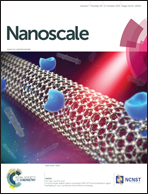Large area nanoscale metal meshes for use as transparent conductive layers†
Abstract
We report on the experimental realization of using super-aligned carbon nanotubes (SACNTs) as etching masks for the fabrication of large area nanoscale metal meshes. This method can easily be extended to different metals on both rigid and flexible substrates. The as-fabricated metal meshes, including the ones made of gold, copper, and aluminum, are suitable for use as transparent conductive layers (TCLs). The metal meshes, which are similar to the SACNT networks in their dimensional features of tens of nanometers, exhibit compatible performance in terms of optical transmittance and sheet resistance. Moreover, because the metal meshes are fabricated as an integrated material, there is no junction resistance between the interconnected metal nanostructures, which markedly lowers their sheet resistance at high temperatures. The fabrication of such an effective etching mask involves a simple drawing process of the SACNT networks prepared and a common deposition process. This approach should be easy to extend to various research fields and has broad prospects in commercial applications.


 Please wait while we load your content...
Please wait while we load your content...